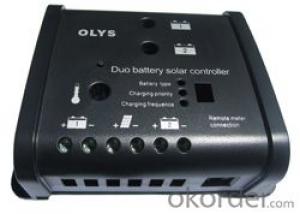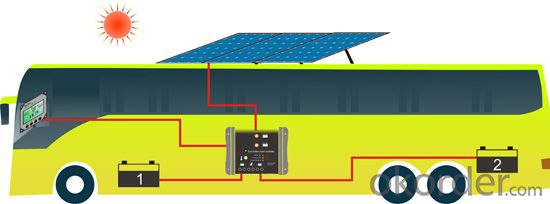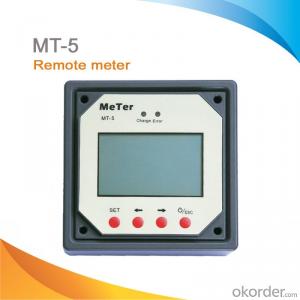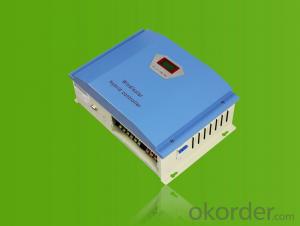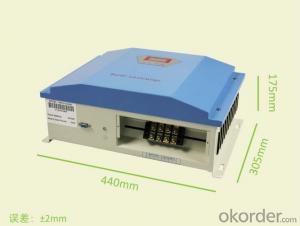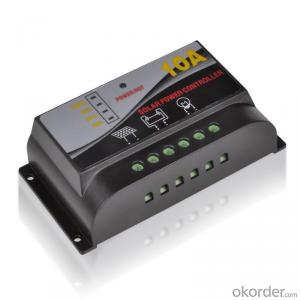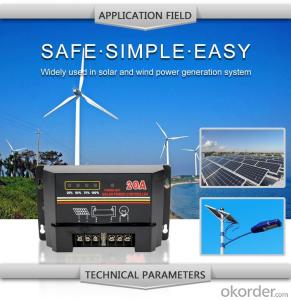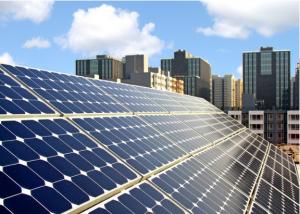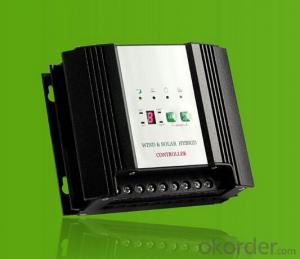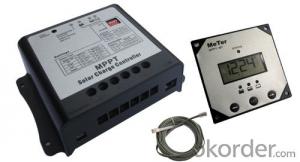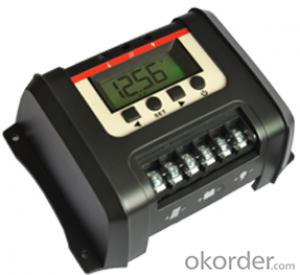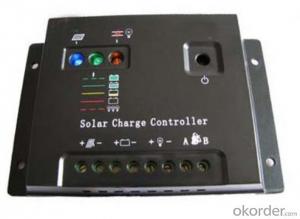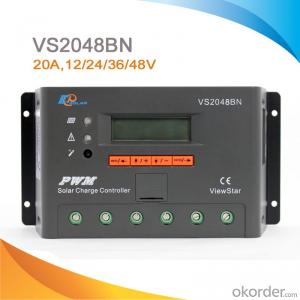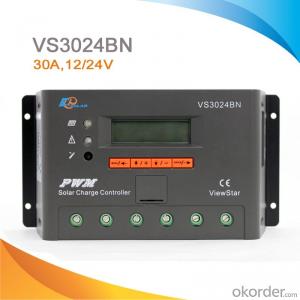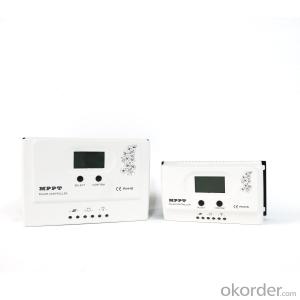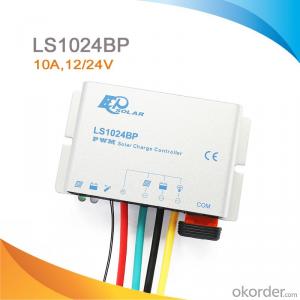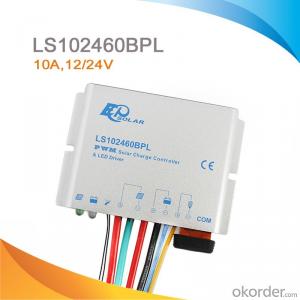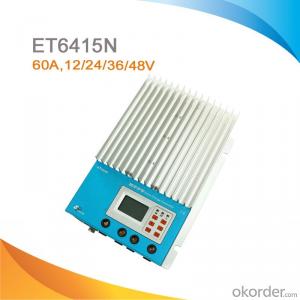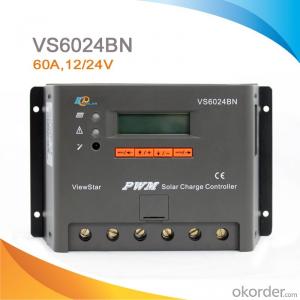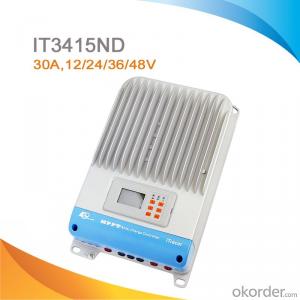One Solar Charge Controllers:RV Solar Power Controller with LCD Display & Remote Meter (Options)
- Loading Port:
- Shekou
- Payment Terms:
- TT OR LC
- Min Order Qty:
- 100 unit
- Supply Capability:
- 100000 unit/month
OKorder Service Pledge
OKorder Financial Service
You Might Also Like
1.The controller is ideal for use with motorhomes, caravans, boats or anywhere there are two independent batteries for instance a starter battery and a leisure battery.
2.Optional LCD Remote meter, you can monitor the charging parameter visual.
3.Automatic recognize 12V or 24V system.
4.The Charging percentages for each battery can be set manually if required.
5.PWM charging, high precision temperature compensation
6.Over charging, short-circuit, reverse polarity & reverse current to PV Protection
Technical data
Float voltageMODEL SDC10 SDC20 Maximum charge current 10A 20A Regulation voltage Automatic recongnize 12V/24V battery type Sealed battery Gel battery Flooded battery regulate voltage 14.2V 14.4V 14.6V Boost voltage 14.4V 14.6V 14.8V 13.7V 13.7V 13.7V Maximum solar voltage 30V Battery voltage range 1-15V Self-consumption 4mA at night, 10mA at charging Metebus connection 8PIN RJ45, 10m Temp.compensation -30mV Terminals 4mm2 temperature -35℃~55℃ Dimension 136.6×104.6×43.4mm weight 0.2kg(main), 0.15kg (remter) IP IP22
All the data is for 12V, For 24V, use 2×
- Q: Can a solar controller be used in a solar-powered spacecraft propulsion system?
- Yes, a solar controller can be used in a solar-powered spacecraft propulsion system. A solar controller is responsible for regulating and optimizing the charging of batteries in a solar power system. In a solar-powered spacecraft propulsion system, solar panels collect energy from the sun and convert it into electrical power. This power is then stored in batteries, which can be used to power various systems, including the propulsion system. The solar controller ensures that the batteries are charged efficiently and protects them from overcharging or discharging.
- Q: Do solar controllers require regular maintenance?
- Yes, solar controllers do require regular maintenance. While they are designed to be durable and reliable, regular maintenance is necessary to ensure their optimal performance and longevity. Some common maintenance tasks include cleaning the solar panels to remove any dirt or debris that could reduce their efficiency, inspecting the wiring and connections for any signs of damage or corrosion, and checking the controller's display and settings to ensure they are functioning properly. Additionally, it is recommended to periodically test the system's battery voltage and charge controller settings to ensure they are operating within the desired parameters. Regular maintenance not only helps to identify any potential issues early on but also helps to maximize the efficiency and lifespan of the solar controller.
- Q: How do I integrate a solar controller with a smart home automation system?
- To integrate a solar controller with a smart home automation system, you need to ensure compatibility between the solar controller and your smart home automation hub or platform. First, check if your solar controller has any built-in communication protocols like Wi-Fi, Zigbee, or Z-Wave. If it does, you can connect it directly to your smart home hub. If not, you may need to use a third-party gateway or bridge that can translate the communication signals from the solar controller to the smart home automation system. Once connected, you can then monitor and control your solar system through your smart home automation app or interface, allowing you to manage energy production, track usage, and automate actions based on solar generation.
- Q: How do I connect multiple solar controllers together?
- To connect multiple solar controllers together, you will need to follow a few steps: 1. Identify the type of solar controllers you have: Before connecting them together, it's crucial to ensure that the solar controllers are compatible with each other. Check the specifications and features of each controller to verify if they can be connected in parallel or series. 2. Determine the connection method: There are two common methods for connecting multiple solar controllers - parallel and series. Parallel connection involves connecting the positive terminals of all controllers together and the negative terminals together. Series connection, on the other hand, requires connecting the positive terminal of one controller to the negative terminal of the next controller. 3. Connect the solar controllers: Once you have determined the appropriate connection method, you can start connecting the controllers. Ensure that all connections are secure and tight to avoid any loose connections or electrical faults. Use appropriate wiring and connectors depending on the size and type of the controllers. 4. Configure the controllers: After connecting the controllers physically, you may need to configure some settings for them to work together efficiently. Consult the user manuals or documentation provided with the controllers to understand how to configure them correctly. This may involve adjusting charging parameters, setting priority modes, or synchronizing the controllers. 5. Monitor and test: Once the controllers are connected and configured, it's essential to monitor their performance and test their functionality. Keep an eye on the charging and discharging patterns, battery voltage, and any error messages or alarms. Regularly check the system to ensure that all controllers are functioning correctly and charging the batteries effectively. Remember, it's important to consult a professional or refer to the manufacturer's guidance if you are unsure about any aspect of connecting solar controllers together. Safety should always be a priority when dealing with electrical connections, especially when it comes to solar power systems.
- Q: Can a solar controller be used with a solar-powered water filtration system?
- Yes, a solar controller can be used with a solar-powered water filtration system. A solar controller helps regulate the flow of electricity from the solar panels to the filtration system, ensuring optimal performance and preventing overcharging or damage to the system's batteries.
- Q: How do you connect solar panels to a solar controller?
- To connect solar panels to a solar controller, you will typically need to connect the positive (+) and negative (-) leads of the solar panels to the corresponding terminals on the solar controller. This is usually done by using appropriate wires or cables and ensuring a secure connection. It is important to follow the specific instructions provided by the manufacturer of your solar panels and solar controller to ensure proper and safe installation.
- Q: Can a solar controller be used with a solar-powered military base?
- Yes, a solar controller can be used with a solar-powered military base. A solar controller is an essential component in a solar power system as it regulates the flow of electricity from the solar panels to the batteries, ensuring efficient charging and preventing overcharging or damage. In a solar-powered military base, a solar controller would be necessary to manage the energy production and storage, helping to optimize the use of solar power and ensure reliable and sustainable energy supply for the base's operations.
- Q: Can a solar controller be used with a battery bank?
- Yes, a solar controller can be used with a battery bank. A solar controller helps regulate the charging process of the batteries in a battery bank, ensuring they are not overcharged or damaged. It monitors the voltage and current from the solar panels and manages the flow of energy to the batteries, optimizing their performance and extending their lifespan.
- Q: How do you test the functionality of a solar controller?
- To test the functionality of a solar controller, you can follow these steps: 1. Connect the solar controller to a solar panel and a battery bank, ensuring all connections are secure and properly wired. 2. Verify that the solar controller is receiving power from the solar panel by checking the LED indicators or digital display, if available. 3. Monitor the charge status of the battery bank to ensure the solar controller is effectively regulating the charging process. The battery should show an increasing charge level over time. 4. Test the different charging modes and settings of the solar controller, such as bulk, float, or equalization charging, to ensure they function correctly. 5. Measure the voltage output of the solar controller to confirm it matches the expected values for the specific battery bank. 6. If applicable, test any additional features of the solar controller, such as load control or temperature compensation, to ensure they are operating as intended. 7. Observe the controller's behavior during different weather conditions, such as low light or cloudy skies, to assess its ability to adjust charging parameters accordingly. 8. Finally, compare the solar controller's performance with the manufacturer's specifications to ensure it meets the expected standards. By following this testing process, you can evaluate the functionality and performance of a solar controller and ensure its proper operation in a solar power system.
- Q: Can a solar controller be used with solar water heating systems?
- Yes, a solar controller can be used with solar water heating systems. A solar controller is designed to regulate and optimize the performance of solar panels or collectors, including those used in solar water heating systems. It helps to control the flow of heat transfer fluid, monitor temperatures, and prevent overheating or freezing. Additionally, it can provide data and feedback to ensure efficient use of solar energy for heating water.
Send your message to us
One Solar Charge Controllers:RV Solar Power Controller with LCD Display & Remote Meter (Options)
- Loading Port:
- Shekou
- Payment Terms:
- TT OR LC
- Min Order Qty:
- 100 unit
- Supply Capability:
- 100000 unit/month
OKorder Service Pledge
OKorder Financial Service
Similar products
Hot products
Hot Searches
Related keywords
